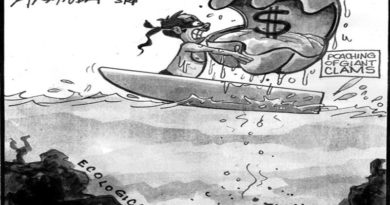COLUMN-CANADIAN VISA: Analysis: Ontario – From the city or promdi, Canada’s provinces welcome you
ONTARIO is the largest economy in Canada. It is also the most populous political and geographical unit of Canada, with a population of more than 14 million, home to 40 percent of Canada’s population.
If it were a US state, Ontario says it would rank fifth in population. However, Ontario is a province, but not a province in the sense that we know in the Philippines.
Before it emerged as the economic engine of Canada, Ontario and the other Canadian provinces were not given full rights to determine their destinies.
Until the 1960s when Quebec asserted its right to have a say in governing the province, Canada’s provinces were sidelined from immigration matters.
The first of four immigration agreements with the federal government was signed in 1971. Its terms were modest; the Quebec government was authorized to post an information officer in designated countries. The 1975 agreement gave Quebec a modest role in immigrant selection, and this was enhanced in 1978.
In 1991, Citizenship and Immigration Canada and Quebec signed the McDougall/Gagnon-Tremblay Accord allowing the Quebec government “the power to select all economic immigrants to the province.” The federal government could overrule candidates only for serious security or medical reasons.
The points system became the precursor of the Federal Skilled Worker Program. With the introduction of Express Entry as Canada’s immigrant selection system, the provinces were granted additional allocation from the annual immigrant target.
By then, the provinces had their own selection streams in place to respond to the provinces’ needs.
Now, the Provincial Nominee Class (PNC) allows provincial and territorial governments to choose immigrants according to the economic needs of the province or territory: Alberta, British Columbia, Manitoba, New Brunswick, Newfoundland-Labrador, Northwest Territory, Nova Scotia, Nunavut, Ontario, Prince Edward Island, Saskatchewan and the Yukon Territory.
Each province and territory establishes its own standards and processes by which it chooses its nominees and nominates those candidates who would be most likely to settle effectively into the economic and social life of the region.
The application through the PNC involves two steps: submitting the application to the province or territory where an applicant intends to live and be nominated; and after nomination by the province, applying to Immigration Refugee and Citizenship Canada (IRCC) for permanent residence.
Family members
While the US does not recognize a common-law relationship to enable sponsorship, Canada does. The applicant’s family members –spouse or common-law partner, dependent children and any children considered as their dependent children—may be included in the application.
Common-law partner refers to “a person who is living in a conjugal relationship with another person (opposite or same sex) and has done so continuously for a period of at least one year. A conjugal relationship exists when there is a significant degree of commitment between two people.
This can be shown with evidence that the couple share the same home, support each other financially and emotionally, have children together, or present themselves in public as a couple.”
Dependent children
US immigration law sets a child’s eligibility to be petitioned or sponsored at 20. When the child (biological, step or adopted) turns 21, he or she loses the child status and converts to another immigrant category.
Canada considers a child still a “dependent child” (of the sponsoring parent or the child of the spouse or common-law partner) eligible for sponsorship if that child meets the following requirements on the day the complete application is received: they’re under 22 years old, and they don’t have a spouse or common-law partner
Children 22 years old or older qualify as dependents if they have depended on their parents for financial support since before the age of 22, and they are unable to financially support themselves because of a mental or physical condition
Applying as provincial nominee
Each province and territory have their own streams and criteria for their Provincial Nominee Program (PNP).
Given the success of the Federal government’s Express Entry selection system, most of the provinces have their own Express Entry stream and others are heading in the same direction. However, to ensure that smaller, less-known provinces get their share of immigrants, Canada set up the Atlantic Immigration Pilot Project which covers the four provinces of New Brunswick, Newfoundland and Labrador, Nova Scotia and Prince Edward Island.
These provinces were receiving considerably less immigrants than the others. In contrast, the four provinces popular with newcomers—Ontario, Alberta, British Columbia, Manitoba—get tens of thousands yearly.
Employer-driven, the Atlantic Immigration Pilot allows employers in the participating provinces to apply for designation as a program partner. Atlantic employers (such as businesses, not-for-profits, governments) then become eligible to offer jobs to skilled foreign workers and recent international graduates. These jobs must be in the province where the employer is designated.
Eligibility criteria for PNP
The eligibility criteria for the PNP is different based on whether you apply through the paper-based (non-Express Entry streams) or Express Entry (Express Entry streams) process.
Applying through the paper-based process must meet the minimum requirements of one of the province or territory’s non-Express Entry streams and then be nominated under that stream.
Those applying through Express Entry must meet the minimum requirements of a province or territory’s Express Entry PNP stream; be nominated under that stream and create an Express Entry profile and show that you meet the minimum criteria for Express Entry, including the requirements of one of the immigration programs it covers.
In both cases, immigrants must have the skills, education and work experience to contribute to the economy of that province or territory and must want to live there.
Applicants are encouraged to use the Express Entry application process instead of submitting a paper-based application not only because of faster delivery and therefore faster processing but more importantly because monitoring of the processing and submitting changes in the applicant or dependent’s personal information could be done online.
Settlement funds
Applicants must have enough money to settle in Canada, to meet the minimum requirements of the Federal Skilled Worker Program or the Federal Skilled Trades Program. The funds must be used to pay the costs of living for your family (even if they aren’t coming with the applicant to Canada).
The amount of money required is set by the size of applicant’s family, which includes the applicant, spouse or partner, dependent children and spouse’s dependent children, including those who are permanent residents or Canadian citizens.
PNP applicants usually need to provide settlement funds of $10,000 for the principal applicant and $2,000 for each dependent. BY CRISPIN R. ARANDA ON










